10 Hidden Natural Wonders in Mexico When You Want to Avoid the Crowds
From secret waterfalls to under-the-radar jungles, these natural wonders in Mexico are true hidden gems.
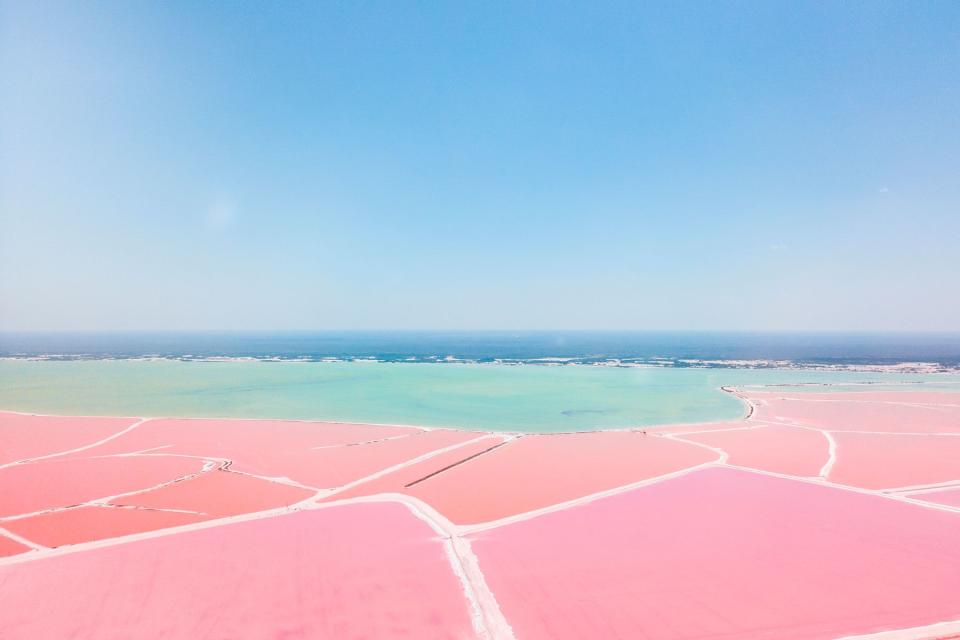
There's no denying the sheer beauty of a powder-soft Mexican beach. The vast, expansive stretches of sand backed by groves of languidly swaying palm trees are what put Mexico on the tourist map in the first place. Yes, Mexico's beaches are truly among the best in the world. But a closer look at its natural wonders will reveal that the country is home to so much more than its captivating coastline.
Mexico has some of the most diverse topography in the world. Its mountains max out at more than 18,000 feet, and its canyons are wider and deeper than our own most famous. It's a country of gushing waterfalls, raging rivers, alpine villages, deserts, and secret-laden jungles. The natural beauty that many travelers fly halfway around the world to see can be found right here on this continent, just a short flight away. With that mind mind, here are 10 stunning natural wonders in Mexico that are truly hidden gems.
<strong>Hierve el Agua, Oaxaca</strong>

The city of Oaxaca checks all the boxes when it comes to a dream Mexico vacation: cuisine, culture, history, and design. But just outside of the city of Oaxaca is one of the most spectacular natural wonders in the entire country: Hierve el Agua, a petrified rock formation that gives the illusion of a cliffside gushing waterfall, perfectly frozen in time. At the top of the cliff, you'll find a series of natural mineral pools that overlook the green-carpeted mountains that undulate in every direction as far as the eye can see.
Hierve el Agua is the result of the calcification of natural springs that have been pushed to the edge of a cliff. The result is a mesmerizing optical illusion that appears as if a waterfall is paused while tumbling down the towering cliff.
The best way to visit this site is to rent a car or hire a driver to take you. Tour buses are another option. Tip: Go as early as possible to experience it all to yourself. Small shops and vendors are open near the entrance, in case you're craving a refreshing snack of fresh fruit dusted with tajin, a popsicle, or even an ice-cold beer. But what you're coming for here are the spectacular views, and perhaps an enviable Instagram snap or two.
Related:8 Can't-miss Destinations on a Road Trip Along Oaxaca's Wild Coast
<strong>Copper Canyon, Chihuahua</strong>
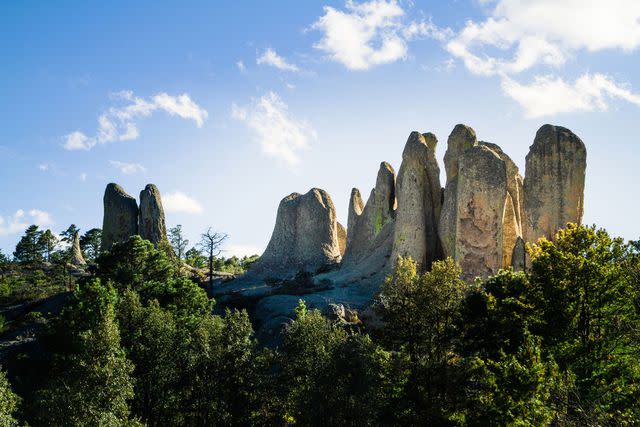
America's Grand Canyon is something spectacular. But did you know that Mexico has its own version that is arguably more profound? Known as Barrancas del Cobre (Copper Canyon), this massive system of plunging ravines is actually the culmination of six different canyons that run across the northwestern part of Mexico.
Spanning more than 25,000 square miles, this canyon is even larger than the Grand Canyon in the U.S. The canyons have been carved by six different rivers that all empty out into the Gulf of California. And it gets its name from the rust-colored walls that tower high above the river-carved ravines.
To visit the canyons, book a ticket along the Ferrocarril Chihuahua al Pacífico railway, otherwise known as El Chepe. The stunning rail route follows the trail along the main canyon, traversing suspended bridges and hugging the cliffs that overlook the sheer drops down into the valleys. Ride the route in its entirety, or get off at stops along the way to hike or explore the communities that have lived in this part of Mexico for centuries.
<strong>Sumidero Canyon, Chiapas</strong>
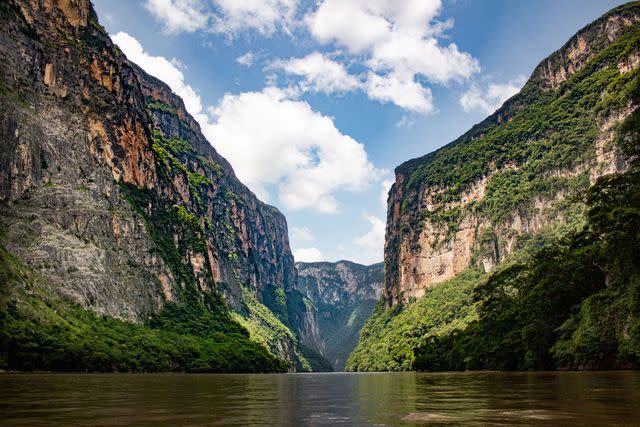
Mexico's state of Chiapas is a natural wonder all on its own, with misty, cool mountains and thick, steamy jungles. Descending from the lofty peak that is the city of San Cristobal de las Casas, travelers zigzag down a mountain path to reach the plunging valley of the Sumidero Canyon.
This natural canyon was carved by the Grijalva River, with 3,000-foot towering rock walls on either side. The site was declared a national park in the 1980s, and it's no wonder why. The views from the six lookout points along the canyon's rim are simply breathtaking.
Perhaps the most popular way to explore the canyon is via a boat tour that meanders down the river, allowing visitors to gape up at the imposing rock walls. But those who opt out of a boat tour can still make the most of this park with hiking, kayaking, and rappelling. Keep in mind that you'll likely still need a guide because the park is teeming with precarious yet beautiful wildlife, like jaguars, crocodiles, and rattlesnakes.
<strong>Isla Espiritu Santo, Baja California Sur</strong>

Keep your ears to the ground in the next few years — you'll start to hear more and more about the city of La Paz. Poised on the Sea of Cortez, the capital of Baja California Sur is slowly gaining momentum to become one of the best destinations to visit in Mexico. And while you're there, you are going to want to schedule in some time to visit Isla Espiritu Santo.
The island looks like it's out of the pages of a sci-fi novel. Copper-colored mountainous spines rise out of a calm, turquoise sea. This UNESCO World Natural Heritage site and national park offers some truly beautiful views, where stark desert sits atop one of the world's most diverse marine ecosystems.
You won't see hotels on Espiritu Santo — that would completely ruin the vibe. Instead, you'll find dive sites, natural reefs, and sunken ships. Calm, languidly lapping water makes the perfect palette for stand-up paddleboarding, while miles of hiking trails arch up and over the rusty ridges for views in every direction.
Related:10 Small Towns in Mexico for Natural Beauty, Arts, Culture, and Tequila
<strong>Calakmul, Campeche</strong>
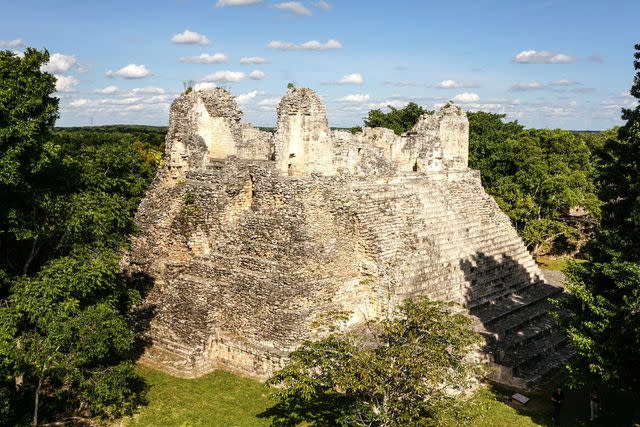
The state of Campeche is shrouded in both jungle and mystery. Away from the capital city that sits on the Gulf of Mexico, travelers are immediately plunged into a hot, steamy jungle. In fact, it is this protected jungle that takes up the majority of the entire state, and within it are some of the region's best-kept secrets.
Enter Calakmul, an ancient Mayan city that's the beating heart of the Calakmul Biosphere Reserve. What's so enigmatic about Calakmul is that there's still so much we don't know. What we do know, however, is that it was a thriving powerhouse in the Mayan world, sitting just 22 miles from what is now the Guatemalan border. In its most powerful years, it was the rival city to Tikal, the most famous Mayan city in present-day Guatemala.
Calakmul translates to the "City of the Two Adjacent Pyramids," and its peak was from 600 to 900 A.D. It was home to more than 50,000 residents, who lived among 6,700 buildings. The site spans seven square miles, though only a small percentage of that has actually been excavated and is open to the public. The rest still lies in wait, covered by thick jungle, and time.
<strong>Las Coloradas, Yucatan</strong>

Mexico is not one to skimp on color, and if you're looking for a mind-blowing palette, a visit to Las Coloradas is certainly in order. Perched at the top of the Yucatan Peninsula, where the land meets the Gulf of Mexico, lies one of the most visually stunning spots in the country.
Picture cotton candy-hued pools that touch up against pale, pastel blues, with edges of emerald green from the surrounding Rio Lagartos Biosphere Reserve. This protected wetland area is known as Las Coloradas, a series of bright pink lakes that are peppered across the landscape alongside the Gulf of Mexico.
The wetlands are home to jaguars, sea turtles, flamingos, and crocodiles, which inhabit the 150,000-acre protected area. The reserve itself is mesmerizing, but it's the blush-colored pools that are the jewels in the crown. The lagoons are pink due to the algae, plankton, and shrimp that live in this super-saline solution. In fact, Las Coloradas is known for its salt production here in this part of Mexico.
A lot has changed in Las Coloradas, as its bubble gum-pink pastels have now been plastered across Instagram. A once-hidden gem has become a popular spot for influencers and content creators to come and get the perfect shot. You'll find more tour buses here than ever before, which may dampen the experience a bit. But the colors are still absolutely stunning.
<strong>Tamul Waterfall, San Luis Potosi</strong>
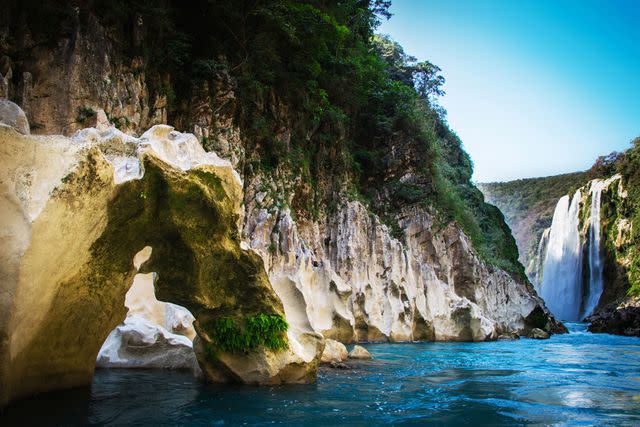
Gushing from a towering 340 feet, the Tamul Waterfall crashes from the cliffs and dramatically cascades into the Tampaón River. The waterfalls of the state of San Luis Potosi are famous across Mexico, and the Tamul Waterfall is the most breathtaking of the bunch.
Cascada de Tamul is known for its turquoise hues, and for the powerful force with which it plunges down the cliffs. It's the result of the Gallinas River and Santa Maria River coming together to create a breathtaking 1,000-foot-wide waterfall.
Accessing the waterfall is not an easy feat, as it takes a bit of an adventurous spirit and some planning. But for those who make the effort, the reward is certainly worth it. You can reach the waterfalls from the town of Tanchachin, and they're about a two-hour ride upstream in a small panga boat. Avoid visiting in the summer, when the heavy rains make the experience far more challenging. You'll also want to steer clear of holidays, as that's when the crowds flood in.
<strong>Peña de Bernal, Querétaro</strong>

The town of San Sebastián Bernal is blessed with a guardian. Towering more than 1,100 feet above this colonial 17th-century village is the looming Peña de Bernal — a national treasure and one of the largest monoliths in the world.
Peña de Bernal, rising more than 8,000 feet above sea level, has long been a sacred site for the Indigenous Otomi-Chichimeca people. To this day, you'll still find descendants of this group making a pilgrimage to the summit in a glorious, painstaking procession, carrying a wooden cross that weighs nearly 200 pounds.
At the summit of Peña de Bernal is a sweeping panoramic view of the state of Querétaro. A groomed hiking trail leads up one of its sides, but in order to summit the monolith, some skills are required — the last 150 feet is sheer, vertical rock face. Still, even if you enjoy Peña de Bernal from the ground, it's one of the most spectacular natural wonders to behold in central Mexico.
<strong>Nanacamilpa Firefly Sanctuary, Tlaxcala</strong>

Central Mexico's Piedra Canteada forests seem to leap from the pages of a fairy tale. As the sun sets and the sky turns inky blue, the thick, shadowy forests start to hum with an ethereal glow. Every summer, from June through August, hundreds of thousands of fireflies come alive in the darkness, illuminating the wilderness with pure magic.
This is the Nanacamilpa Firefly Sanctuary, and it's truly something out of a storybook. Covering the base of the Iztaccíhuatl and Popocatépetl volcanoes, roughly 60 miles from Mexico City, the forests simply sparkle with these celestial floating constellations of fireflies. During mating season, the village offers forest tours and several eco-hotels permit guests to spend the night.
<strong>Pico de Orizaba, Veracruz</strong>
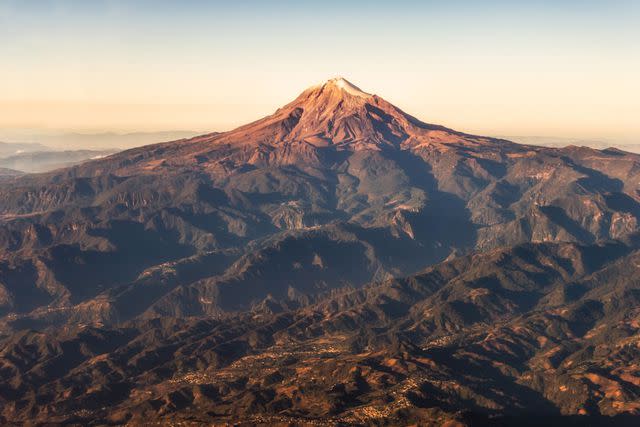
Mexico has its fair share of superlatives — best beaches, oldest ruins, most delicious cuisine. But it also happens to be home to one of the tallest dormant volcanoes in the world. Meet Pico de Orizaba, the third highest mountain in North America.
Clocking in at nearly 18,500 feet above sea level, this central Mexico landmark is where professional climbers go to practice before attempting Mount Everest. Located 220 miles east of Mexico City, it's one of Mexico's most important climbing mountains, and a beacon that has withstood the test of time.
Orizaba comes from the Aztecan name Ahuilizapa, which means "Place of the Playing Water." Its last eruption was 1846, and its slopes are coated with glaciers — nine, to be exact.
For more Travel & Leisure news, make sure to sign up for our newsletter!
Read the original article on Travel & Leisure.
